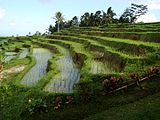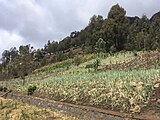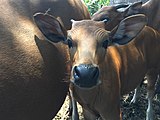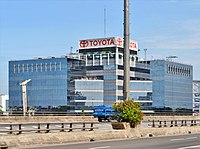Indonesian economy
Indonesia, a vast and polyglot nation, has weathered the global financial crisis relatively calmly, because the main engine of its economic growth is domestic consumption. The growing investment made by both local and foreign investors also helps maintain solid growth. Despite the growth of the economy having fallen from more than 6% in 2007 and 2008 to 4.5% in 2009, in 2010 it returned to the level of 6%. The country is one of the main oil exporters, tin and rubber in the world, most of its population is still linked to subsistence agriculture, fishing and logging. Indonesian-owned businesses or industrial enterprises have traditionally been few, with production focused on items for export. In the early 1960s, the government, to correct the balance of a colonial economy, nationalized foreign companies. With government stabilization policies and large amounts of foreign aid money coming in, the Indonesian economy, which nearly went bankrupt before 1966, began to show signs of a strong recovery.
Within the framework of this stabilization policy, a five-year plan was established (from 1979 to 1983), whose objectives were to increase employment opportunities, increase food production, establish a distribution of wealth based on more egalitarian and achieve an average annual economic growth of 6.5%. The five-year plan for 1984 to 1989 had a more modest annual growth target of 5%, as declining prices for major Indonesian items forced the government to lower the bar on its aspirations. The estimated annual budget in the late 1980s had $10.5 billion in revenue and $13.9 billion in spending.
Indonesia was part of OPEC from 1962 to 2008.
The oligarchy born under the New Order regime is appropriating most of the fruits of Indonesia's robust economic growth. In 2017, an Oxfam report ranked Indonesia as the sixth most unequal country; the richest 1% own 49% of the wealth. Through control of the media and party funding, these oligarchs wield considerable influence in political life.
Foreign trade
In 2020, the country was the 32nd largest exporter in the world (US$167.4 billion, 0.9% of the world total). In the sum of exported goods and services, it reaches US$200.1 billion, ranking 29th in the world. On imports, in 2019, it was the 29th largest importer in the world: 170.7 billion dollars.
Primary sector
Agriculture
Indonesia produced in 2018:
- 38 million tons of palm oil (the world's largest producer);
- 83.0 million tons of rice (third world producer behind China and India);
- 30.2 million tons of corn (global producer submission);
- 21.7 million tons of sugar cane (12th world producer);
- 18.5 million tons of coconut (the world's largest producer);
- 16.1 million tons of cassava (global producer submission);
- 7.2 million tons of bananas (fifth world producer);
- 3.6 million tons of natural rubber (second world producer, only behind Thailand);
- 3.0 million tons of mango (including mangostan and guava) (the world's largest producer quartz, only behind India, China and Thailand);
- 2.5 million tons of aji (world producer quartz behind China, Mexico and Turkey);
- 2.5 million tons of orange (eight world producer);
- 1.8 million tonnes of pineapple (fifth world producer, only behind Costa Rica, the Philippines, Brazil and Thailand);
- 1.8 million tons of sweet potatoes (global producer submission);
- 1.5 million tons of onion (the 14th world producer);
- 1.4 million tons of cabbage;
- 1.2 million tons of potato;
- 976 thousand tons of tomatoes;
- 953 thousand tons of soy;
- 939 thousand tons of beans;
- 887 thousand tons of papaya (fifth world producer, only behind India, Brazil, Mexico and the Dominican Republic);
- 722 thousand tons of coffee (third world producer, behind Brazil and Vietnam);
- 593 thousand tons of cocoa (third world producer, only behind Ivory Coast and Ghana);
- 410 thousand tons of avocado (world producer quartz, only behind Mexico, Dominican Republic and Peru);
In addition to smaller productions of other agricultural products, such as leeks (573 thousand tons), eggplant (551 thousand tons), cucumber (433 thousand tons), ginger (207 thousand tons), cashew nut (136 thousand tons, tenth largest producer in the world), cloves (123 thousand tons), areca nut (128 thousand tons), kapok fruit (196 thousand tons), tea (141 thousand tons), tobacco (181 thousand tons, sixth largest producer in the world) etc.
About 12% of the land is cultivated; much of the arable land is in Java. Approximately 55% of the country's workforce, some 70.4 million workers, are engaged in agriculture, either as small farm owners or as day laborers on other properties. Small farms, which grow subsistence crops, also contribute significantly to rubber and tobacco cultivation and total export production. The plantations produce rubber, tobacco, sugar, palm oil, coffee, tea and cocoa, which are mainly for export.
Rice is the country's staple food; its annual production in the late 1980s was (in t) 41.8 million. Most of the rice is grown in Java. Other important crops are cassava, maize, sweet potatoes, coconuts, sugar cane, soybeans, groundnuts (peanuts), tea, tobacco, and coffee. The annual production of rubber is approximately 1.1 million t. Banks and farm cooperatives have fueled increased crop production and marketing. However, large quantities of food products, including rice, have yet to be imported.
Livestock
In livestock, Indonesia produced, in 2019: 3.4 million tons of chicken meat (sixth largest producer in the world); 4.7 million tons of chicken eggs (fourth largest producer in the world); Billion liters of cow's milk; 369 million liters of goat's milk; 490 thousand tons of beef; 224 thousand tons of pork, among others.
Forestry and fishing
Almost two-thirds of Indonesia is covered by forest and jungle, especially in Borneo, Sumatra and eastern Indonesia. Almost all forest areas are owned by the State. Raw timber production reached 173.6 million m³ per year in the late 1980s. In addition to industrially valuable timber, teak, ebony, bamboo and rattan were produced in significant quantities. Indonesia is the world's leading exporter of veneer or plywood.
Fish is a vital part of the diet, with much of the annual catch coming from part-time fishers for livelihood. At the end of the 1980s the marine fish catch was 2 million tons and river fishing produced approximately 638,000. The main species caught are carp, tuna, mackerel, horse mackerel, sardines and shrimp.
Secondary sector
Industry
The World Bank lists the top producing countries each year, based on the total value of production. According to the 2019 list, Indonesia had the 11th most valuable industry in the world ($220.5 billion).
In 2019, Indonesia was the 17th largest producer of vehicles in the world (1.2 million) and the 25th largest producer of steel (6.0 million tons). In 2016, the country was the fifth largest world producer of shoes. In 2018, the country was the world's second largest producer of coconut oil.
Industry accounts for more than 18% of the gross national product and industrial expansion continues to be the main objective of government development programs. In 2010 the industry accounted for 13% of the Indonesian employment structure. Oil refineries, textile industries and the preparation of food products stand out for their importance. Also noteworthy are derivatives of tobacco, veneer, cement and other construction materials, chemical products, radio sets, television receivers and motor vehicles. The industry is concentrated in Java.
Mining
In 2019, the country was the world's largest producer of nickel; 7th world producer of gold; 2nd world producer of tin and 6th world producer of bauxite.
The main mining resources are oil, natural gas, tin, bauxite, coal, manganese, and iron ore. In the late 1980s, Indonesia was among the top oil-producing countries with an annual production of about 500 million barrels. The richest reserves are found, above all, in Sumatra, Java and Borneo. Natural gas production in those same years was 41 billion m³. Indonesia remains one of the world's leading tin producers, although its annual production has declined from a peak of about 35,000 t (concentrated) in the late 1940s, to about 30,600 in the late 1980s. Other annual mineral productions with a certain economic weight are 505,800 t of bauxite, 200203903923.4 million t of coal and 1.7 million t of nickel.
Energy
In non-renewable energy, in 2020, the country was the twenty-first world producer of oil, 712 thousand barrels / day. In 2019, the country consumed 1.6 million barrels / day (the thirteenth largest consumer in the The country was the 23rd largest oil importer in the world in 2013.er (391 thousand barrels/day). In 2015, Indonesia ranked the world's ninth largest producer of natural gas, 86.9 billion m³ per year. In 2015, Indonesia was the twelfth largest gas exporter in the world (30 200 million m³ per year). In coal production, the country was the fifth world producer in 2018: 461.0 million tons. It was the world's largest coal exporter in 2018: 429 million tons.
As a major energy exporter, the country does not feel the need to invest in renewable energy production: in 2020, it produced neither wind power nor solar power.
21% of Indonesia's electricity is generated by hydroelectric power plants and virtually all the rest is produced by thermal facilities. At the end of the 1980s, the country had electrical facilities generating a capacity of about 10.4 million kW and the annual production was about 34.8 billion kWh.
Tertiary sector
Tourism
In 2018, Indonesia was the 31st most visited country in the world, with 13.3 million international tourists. Tourism revenue this year was $14.1 billion.
Currency and banking
The new rupiah, which has a value equivalent to 1,000 old rupees, has been the official currency of Indonesia since 1965 (1,913 rupees equaled $1 in 1991). Bank Indonesia is the country's central bank. Approximately three dozen regional and national banks grant credit to industrial and commercial enterprises. The country also has some 80 private commercial banks and subsidiaries of foreign banks.
International trade
Since 1964 almost all of Indonesia's export and import trade was in the hands of state trading companies. In the late 1980s, major exports included oil and petroleum products, natural gas, and veneer; of minor importance were coffee, rubber, tin, palm oil, tobacco, tea, and pepper. Imports were dominated by machinery, transport equipment, electrical equipment, chemical products, rice, iron and steel, and medicines. Indonesia's main trading partners are Japan, the United States, Singapore, Germany, Taiwan and the Republic of Korea. Annually the value of Indonesia's exports exceeds that of imports; in the late 1980s the country's exports were worth $22.7 billion and imports $16.3 billion.
Transportation
Well-maintained waterways and inter-island shipping are of vital importance to Indonesia's economy. After the withdrawal of Dutch equipment and personnel in 1958, the reconstruction and development of the facilities for the ships has been progressing slowly. The main international trade ports are located near Jakarta and Surabaya (in Java), and in Medan (Sumatra). Borneo and Celebes also have small ports that are mainly dedicated to internal commercial traffic.
In the late 1980s, Indonesia had about 250,000 km of roads, 39% of which were paved. There were also about 6,580 km of railways in the country, most of it in Sumatra, Java and Madura. The main international airline is the state-controlled Garuda Indonesia Airline. The main airports are in Jakarta, Medan and Denpasar.
Work
Since 1908, the moment the trade union movement began in Indonesia, trade unions have played an active role in national life. The largest collective or group of unions is the All Indonesia Workers' Union, founded in 1973. The 40-hour work week is official throughout the country and wages are regulated based on an arbitration system. The Labor Code of 1948 and subsequent legislation provided regulations regarding the work of women and children, working conditions and hours, and vacation days.
According to Amnesty International, several multinationals operating in the country (Wilmar, Nestlé and Unilever, etc) are guilty of "human rights violations". The NGO denounces the presence of children under 10 years of age in palm oil plantations who carry out physically demanding and dangerous jobs, dangerous working conditions due to the lack of adequate work equipment, very low wages for workers, performance targets &# 34;ridiculously tall" with sanctions for those who do not reach them, and the precariousness in which the workers are maintained, without pensions or health insurance.
In October 2020, Parliament passed a law perceived as "ultraliberal". In order to attract foreign investors to Indonesia, the law is expected to cause the loss of certain social benefits, make layoffs easier, reduce severance payments and increase overtime. In addition, by relaxing environmental legislation, it could lead to "uncontrolled deforestation," according to environmental groups. Labor unions and environmentalists organize demonstrations, which lead to clashes with the police and hundreds of arrests.
Contenido relacionado
Annex: Chronology of Chile
28th century BC c.
International Civil Aviation Organization


















